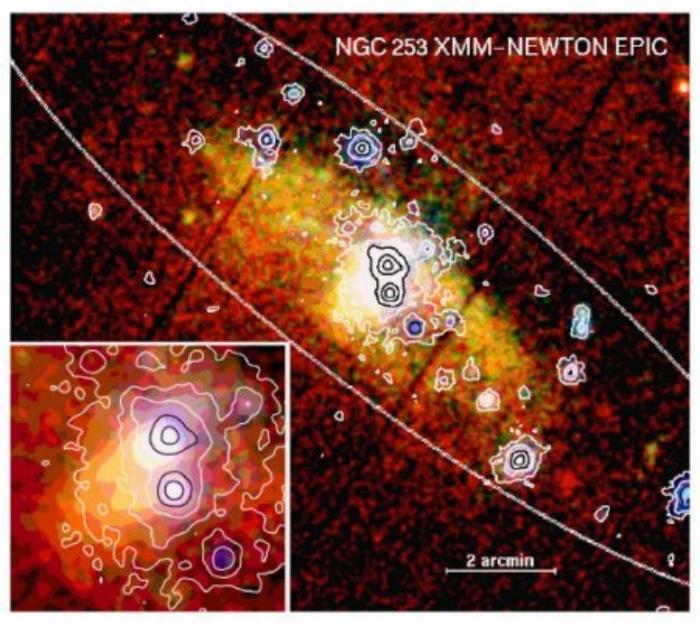
 Credit: Wolfgang Pietsch
Credit: Wolfgang Pietsch
Multi-component Starburst
"Starburst galaxies" are those in which the formation of stars occurs about
100 times the rate of star formation in more normal galaxies (like the
Milky Way). Starburst galaxies produce a large number of massive stars, and
the galaxies can be affected by the massive stars in profound ways. Strong
stellar winds and ultraviolet radiation produced by these stars disrupt and
heat the gas and dust inside the galaxies. These massive stars will
eventually explode as violent supernovae, doing nearly unimaginable damage
and polluting the galaxy with "heavy" elements (like carbon, oxygen and the
other building blocks of life). Because these processes are so energetic
they produce high temperature (millions of degree) gas, and compact
objects like black holes and neutron stars. Since all these objects produce
X-ray radiation, X-ray observations tell quite a bit about the nature of
these phenomena in starbursts. Now the XMM-Newton X-ray observatory has
obtained a detailed
X-ray image of a nearby starburst. This image, shown above, clearly
defines different sources of X-rays in the starburst galaxy known as NGC
253. Inside the galaxy (whose size is indicated by the white ellipse),
diffuse emission is seen surrounding the nucleus of the galaxy; the
emission is color coded by temperature (red-green-blue for cool-warm-hot
X-ray emission). A few strong X-ray point sources are clearly detected;
these are probably old stars which have already collapsed to neutron stars
or black holes. Analysis of this image suggests that, near the center of
the galaxy (shown enlarged in the lower left corner of the image),
supernova explosions occur at the outstanding rate of 1 supernova every
five years (about ten-twenty times the rate of such explosions in the Milky
Way)!
Last Week *
HEA Dictionary * Archive
* Search HEAPOW
* Education
Each week the HEASARC
brings you new, exciting and beautiful images from X-ray and Gamma ray
astronomy. Check back each week and be sure to check out the HEAPOW archive!
Page Author: Dr. Michael F.
Corcoran
Last modified February 19, 2001


